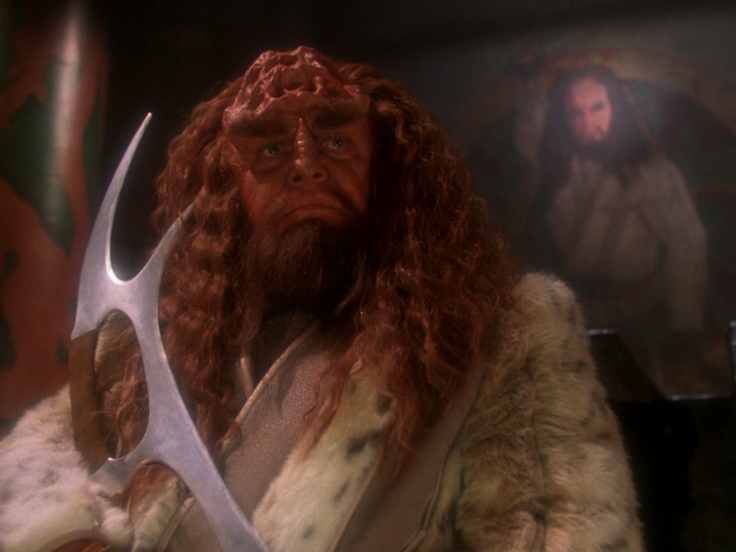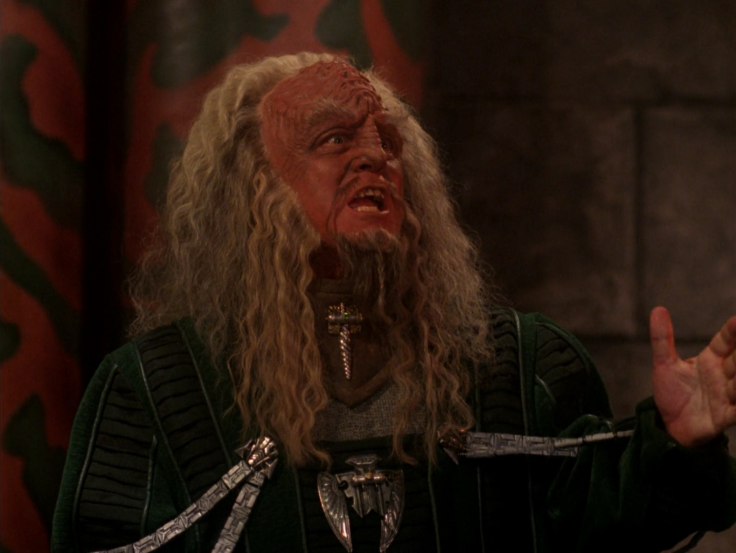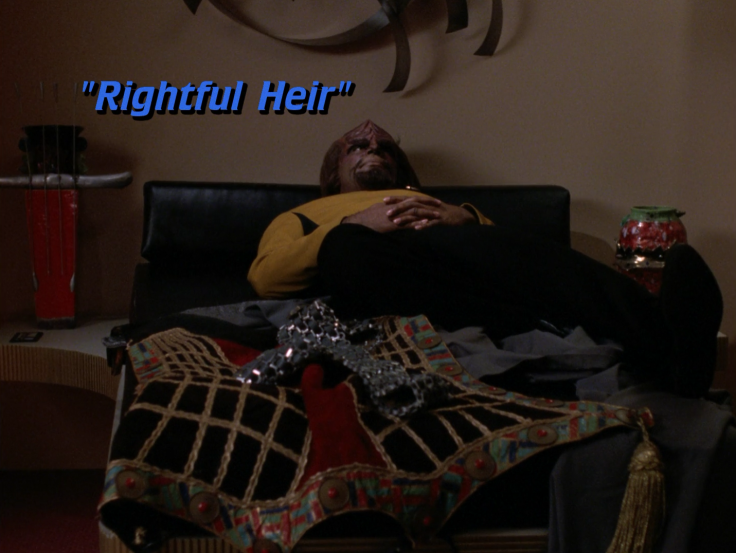As the Sept. 24 premiere of Star Trek: Discovery approaches, Player.One will profile essential episodes to watch for a better understanding of the characters, species and history informing the first Star Trek series in over a decade.
The Klingon T’Kuvma (Chris Obi), leader of a house that bears his name, wishes to unite the 24 Great Houses of the Klingon Empire under a single banner in Star Trek: Discovery. But Klingon honor culture and ritual demands much more than politics to secure a united Klingon Empire. Political unity may only be possible under the auspices of a sacred ritual, requiring a “Sarcophagus Ship” and the activation of a ceremonial obelisk by a ritualized warrior, the Torchbearer.
The details of T’Kuvma’s plan won’t be apparent until the Sept. 24 premiere of Discovery, but there’s the suggestion of religious extremism and demagogic implacability in T’Kuvma’s words in the trailer for the new series: “We must fight for one thing above all: to remain Klingon.” Similar sentiments echo, over a hundred years later, in Star Trek: The Next Generation episode “Rightful Heir.”
In everything we’ve learned about Star Trek: Discovery so far, one name has gone unmentioned: Kahless. It’s unlikely to go unmentioned for long. Kahless is a Klingon religious figure of god-like import, particularly since the Klingon Adam and Eve turned around and killed their creator gods. A combination of Jesus, Mohammed and George Washington, Kahless created the Klingon Empire (sometime in our 9th century AD), wrote their most important scriptures, greets fallen warriors at the gates of Sto-vo-kor and promised to one day return from the dead.
If T’Kuvma hopes to unite the Klingons under a banner of traditional and ritual, the name Kahless is likely to be invoked, just as it is in “Rightful Heir,” in which Worf, meditating on the Klingon holy world Boreth, witnesses the return of Kahless. As Worf struggles with a crisis of faith, the Klingon Empire is faced with a far larger question: if god comes back, do you put him in charge?
“Rightful Heir” begins with Worf smoking himself out in his quarters, losing track of time in an ad-hoc sweat lodge as he chases a vision of Kahless to restore his waning faith in the ancient Klingon ways. At Captain Picard’s urging, he takes leave on Boreth. After many days of meditation, Kahless appears before him. But this Kahless is not a vision; he’s a living, breathing Klingon. And while Worf has many doubts, Kahless allays them one by one, even submitting to a genetic test aboard the Enterprise. Finally convinced that Kahless truly has returned, Worf joins his traditionalist movement to restore Klingon society.

The Klingon Empire suffers disunity in both Star Trek: Discovery’s 2255 and in The Next Generation’s 2369. Gowron, chancellor of the Klingon High Council through much of TNG and Deep Space Nine, barely holds power after a costly civil war. Both Worf and T’Kuvma believe that restoring ancient Klingon virtues will reunite Klingon society. Each, in their own way, hope to spark cultural revolution. And populist revolution is always a threat to entrenched power structures.
But before the battle lines are drawn too sharply, Worf learns the truth: this is a clone of Kahless, manufactured by the high priests to halt what they perceive as the degradation of traditional Klingon values. While the priests have their rationalizations — perhaps Kahless’ prophecy was meant to be fulfilled this way — Worf, let alone Gowron, cannot accept this facsimile, whose brain may be stuffed with Kahless’ words and deeds, but whose body has none of the hard-won combat experience of history’s greatest Klingon warrior.
Worf finds a neat compromise to the Kahless clone situation, proposing to Gowron that the Kahless clone be named Emperor, a defunct figurehead position with symbolic, rather than political, power. From there, the new Kahless could focus on the spiritual rejuvenation of the Klingon people. Only the threat of open rebellion convinces Gowron to accept.
The political landscape in T’Kuvma’s era is likely to be substantially different from the situation in “Rightful Heir.” So while Kahless will almost certainly be invoked, his legacy will be bent toward whatever T’Kuvma hopes to accomplish (a war with the United Federation of Planets looks likely).
More is known about Klingon traditions than those of almost any other Star Trek species. And like our Earthly equivalents, Klingon myths are essentially unverifiable, unknowable and open to motivated interpretation. This leaves room for both priest-class chicanery, like cloning bat’leth Jesus, and demagogues drawing on tradition to justify their own power.

Klingons place a high value in faith and have trouble separating it from dogmatic sycophancy. In “Rightful Heir,” Worf’s doubts result in direct combat with Kahless, a warrior of legendary power. But when it’s clear Worf has the upper hand, Kahless pivots tactics, casting aside his bat’leth and laughing. “We do not fight merely to spill blood, but to enrich the spirit,” he preaches, turning deadly combat into new scripture, “How can you not sing for all to hear: We are Klingons.” Kahless’ followers, many of whom keep their faith even after he’s revealed to be a clone, join him, chanting: “We are Klingons! We are Klingons! We are Klingons!” Is this a moment of empowerment or cultism? And will T’Kuvma be canny enough to exist inside that same ambiguity? We’ll begin to find out when Star Trek: Discovery debuts Sept. 24.
More Essential Star Trek Episodes To Watch Before Star Trek: Discovery
Star Trek: The Original Series “The Cage,” model for DSC protagonist Michael Burnham.
Star Trek: The Original Series “Errand of Mercy,” our introduction to the Klingons.
Star Trek: The Original Series “Journey to Babel,” the first Sarek episode.
Star Trek: The Next Generation "Sarek" and the decline and death of Spock's father.
Star Trek: The Animated Series "Yesteryear" reveals what life was like for a young Michael Burnham as a human on the planet Vulcan.
Star Trek: The Next Generation "Lower Decks" explores stories and characters away from the bridge.
Star Trek: The Next Generation “Rightful Heir” resurrects Kahless, the most important Klingon religious figure.
Star Trek VI: The Undiscovered Country, the best-yet depiction of Federation-Klingon relations.
Star Trek: Deep Space Nine “Trials and Tribble-ations” explores the limits of nostalgia.
Star Trek: The Original Series "A Private Little War" takes Kirk, Bones and Spock to Vietnam.



















